Welcome to the educational program Activity-Focused Dementia Care: Meaningful Activities. This program will help you to understand the importance of meaningful activities in the daily lives of those with Alzheimer’s disease. The goals of this program are to help you define activity-focused dementia care, understand activities as personally meaningful occupation, identify opportunities for using meaningful activities during the day, and discuss different types of meaningful activities.
. . .
This is Lesson 13 of The Alzheimer’s Caregiver. You may view the topics in order as presented, or click on any topic listed in the main menu to be taken to that section.
We hope that you enjoy this program and find it useful in helping both yourself and those you care for. There are no easy answers when it comes to the care of another, as every situation and person is different. In addition, every caregiver comes with different experiences, skills, and attitudes about caregiving. Our hope is to offer you useful information and guidelines for caring for someone with dementia, but these guidelines will need to be adjusted to suit your own individual needs. Remember that your life experiences, your compassion and your inventiveness will go a long way toward enabling you to provide quality care.
Let’s get started.
Prefer to listen to this lesson? Click the Play button below to begin.
Models of Dementia Care
Activity-focused dementia care incorporates meaningful activities into the daily lives of those with dementia. It can include any kind of activity that is meaningful to a person and meets that person’s needs or wants. Therefore an activity can be any personally meaningful occupation. When we broaden our understanding of the full range of activities that can be included in activity-focused care, we become better able to enrich the daily lives of those with dementia.
 Activity-focused care is part of person-centered care, which focuses on individual needs and wants. In person-centered care, caregivers interact with care recipients based on knowledge of and deep respect for them as a unique human beings. It takes into consideration their personal preferences, characteristic habits and routines. Caregivers should learn about the person’s meaningful life experiences, past roles and accomplishments, and cultural norms.
Activity-focused care is part of person-centered care, which focuses on individual needs and wants. In person-centered care, caregivers interact with care recipients based on knowledge of and deep respect for them as a unique human beings. It takes into consideration their personal preferences, characteristic habits and routines. Caregivers should learn about the person’s meaningful life experiences, past roles and accomplishments, and cultural norms.
Activity-focused care is also abilities-focused care. In abilities-focused care, caregivers deliberately identify and encourage the use of an individual’s retained skills and capacities including physical, motor, cognitive, emotional, social and communicative. The goal of abilities-focused care is to compensate for dementia-related problems and limitations and to focus on using remaining abilities to allow for successes.
The very best activity-focused care occurs when all those involved in caregiving participate to provide meaningful activities throughout the day.
The Care Team
When all members of the care team provide activity-focused care, then every encounter with those with dementia provides an opportunity to make genuine human connections, to help individuals with their retained capacities, and to ensure positive emotional experiences.  There are many members in a care team. If the person with dementia lives at home, the team can include all involved family members, friends, healthcare providers, and any home health providers, assistants, or volunteers. If the person lives in a long-term care facility, the care team includes activities directors, social workers, administrators, medical and nursing directors, certified nursing assistants, nurses, physicians, therapists, activities specialists, volunteers, and involved family members. Everybody can provide her or his particular knowledge and skills to make activity-focused care a reality throughout the day. Some of the most important members are family members regardless of whether the person lives at home or in a care facility. More so than any paid or professional caregiver, family members know and understand the person with dementia, including past habits, routines, roles and life accomplishments, as well as current likes and dislikes. They have experience figuring out what does and doesn’t work with their loved one. Certified nursing assistants and other direct care providers are among the most knowledgeable members of the care team about their care recipients and are very familiar with how particular individuals like to be approached and assisted. Physicians can support activity-focused care by identifying and treating medical issues and sources of pain, which can cause someone to cry out, resist, or become agitated when asked to do things.
There are many members in a care team. If the person with dementia lives at home, the team can include all involved family members, friends, healthcare providers, and any home health providers, assistants, or volunteers. If the person lives in a long-term care facility, the care team includes activities directors, social workers, administrators, medical and nursing directors, certified nursing assistants, nurses, physicians, therapists, activities specialists, volunteers, and involved family members. Everybody can provide her or his particular knowledge and skills to make activity-focused care a reality throughout the day. Some of the most important members are family members regardless of whether the person lives at home or in a care facility. More so than any paid or professional caregiver, family members know and understand the person with dementia, including past habits, routines, roles and life accomplishments, as well as current likes and dislikes. They have experience figuring out what does and doesn’t work with their loved one. Certified nursing assistants and other direct care providers are among the most knowledgeable members of the care team about their care recipients and are very familiar with how particular individuals like to be approached and assisted. Physicians can support activity-focused care by identifying and treating medical issues and sources of pain, which can cause someone to cry out, resist, or become agitated when asked to do things.
The Care Team (Continued)
Occupational therapists are experts in using meaningful, everyday activities and in adapting living environments to help people do what they want and need to do as safely, satisfactorily, and independently as possible, while physical therapists are experts in helping people to move and walk, as well as maintain the strength necessary to carry out their activities.
Speech and language pathologists are experts in helping people communicate effectively and can help to address swallowing problems.
 Recreational, music, art and other activity therapists are experts in using activities to help people with dementia have fun, be creative, use their skills, and connect with others.
Recreational, music, art and other activity therapists are experts in using activities to help people with dementia have fun, be creative, use their skills, and connect with others.
Dietitians are experts in how best to meet the nutritional needs of older adults with dementia, as well as in how to prepare and present food so that it will be eaten and provide an adequate meal.
Administrators of nursing homes can create work environments in which activity-focused care is expected of everyone, including themselves and can set examples through their own interactions with residents, as well as how they evaluate the work of others.
Meaningful Occupation
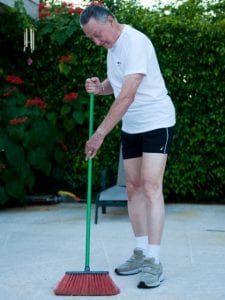 Now let’s discuss the definition of occupation and meaningful activities. Occupation refers to all of the major ways in which people meaningfully occupy their time. Having access to meaningful occupation is essential to people with Alzheimer’s disease, just as it is to all people.
Now let’s discuss the definition of occupation and meaningful activities. Occupation refers to all of the major ways in which people meaningfully occupy their time. Having access to meaningful occupation is essential to people with Alzheimer’s disease, just as it is to all people.
Activities become meaningful occupations when they have a purpose, are socially and age-appropriate, are voluntary and pleasurable, and support the person’s interest and engagement. Basically meaningful activities meet the person’s particular wants and needs.
Case Study 1
Let’s look at a case study with Robert and his caregiver, Mary. They are in the bathroom and Robert is displaying some challenging behaviors concerning his showering.
Let’s begin with an example of Robert, who has early to middle stage Alzheimer’s disease and lives with his wife, Mary. Robert frequently likes to walk outside by himself at night in the enclosed backyard and garden before retiring to bed. He can still walk safely without physical assistance.

Why do you think Robert wants to walk outside at night
- A) Robert enjoys walking.
- B) Robert likes spending time alone.
- C) Walking in nature after dinner has been part of Robert’s evening routine for years.
- D) Walking is one way Robert can get exercise and relax.
- E) All of the above.
Answer:
Choice E: “All of the above” is the best answer.
Any of the answers could account for Robert’s desire to walk outside after dinner.
The purpose of this example is to convey why even a simple activity such as walking outside after dinner can make a difference in the day of those with dementia and their caregivers. Walking outdoors is a meaningful occupation for Robert. When his wish to go outside was not supported, he became argumentative, and upset. His distress also created a problem for the caregiver and disrupted his schedule. So instead of locking the door, Mary could have helped Robert to bundle up in clothes appropriate for the weather and allowed him to follow his normal routine. If she was afraid for his safety walking alone, she could have watched him from a window or sat outside as he walked, or even offered to go for a walk with him. If Robert had been allowed to take his walk, he would have been able to occupy himself in a way that he enjoyed, that prepared him for bed, and that presented fewer problems for Mary. Therefore when a person with dementia wants to do something, it is important to try to understand all of the reasons why that activity is meaningful to her or him. It is the caregiver’s responsibility to balance this need with the person’s safety.Opportunities for Meaningful Activities
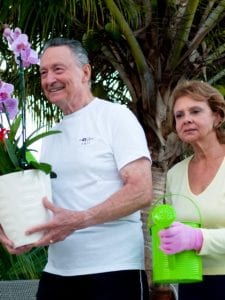 There are many kinds of activities that caregivers can use to enrich the days of those with Alzheimer’s disease beginning from the time they get up in the morning to when they go to sleep at night.
There are many kinds of activities that caregivers can use to enrich the days of those with Alzheimer’s disease beginning from the time they get up in the morning to when they go to sleep at night. Activities involved in caring for someone with dementia include activities of daily living, or ADLs, productive activities, leisure and social activities and finally, spiritual activities.
In caring for someone with dementia, you can include any kind of meaningful activity that meets an individual’s needs or wants.
Let’s discuss each of the listed kinds of activities in more detail.
Activities of Daily Living (ADLs)
Activities of daily living refer to activities that people carry out every day as part of their established daily routines. There are two broad categories according to their purposes, the first is Basic activities of daily living (BADL), while the second is Instrumental activities of daily living (IADL). Both basic and instrumental activities of daily living can be incorporated into activity-focused dementia care with many positive benefits.
Basic Activities of Daily Living (BADLs)
 Examples of BADLs include combing one’s hair, shaving, and brushing one’s teeth. So if a comb is placed in the hand of a woman with severe dementia, it may automatically cause the act of combing her hair, because it is such a habitual action. Another example is dressing. How we dress expresses a lot about who we are as individuals and what we do in our lives. It is important that people with dementia are allowed to participate in dressing themselves to the fullest extent possible. It is also important that what they wear reflects their personal preferences and, if possible, unique identities.
Examples of BADLs include combing one’s hair, shaving, and brushing one’s teeth. So if a comb is placed in the hand of a woman with severe dementia, it may automatically cause the act of combing her hair, because it is such a habitual action. Another example is dressing. How we dress expresses a lot about who we are as individuals and what we do in our lives. It is important that people with dementia are allowed to participate in dressing themselves to the fullest extent possible. It is also important that what they wear reflects their personal preferences and, if possible, unique identities.
Instrumental Activities of Daily Living (IADLs)
Instrumental activities of daily living, or IADLs, are directed outward toward our living environments. IADLs include caring for our homes and 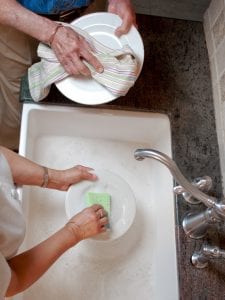 other people. Examples include preparing food, washing dishes, raking leaves, sweeping the floor, and keeping track of money. People with dementia can often still participate in activities like these, because such activities are very familiar and use repetitive, over-learned patterns of movement.
other people. Examples include preparing food, washing dishes, raking leaves, sweeping the floor, and keeping track of money. People with dementia can often still participate in activities like these, because such activities are very familiar and use repetitive, over-learned patterns of movement.
For instance: Even if a woman with dementia can no longer plan a meal or assemble ingredients to cook, she might still be able to stir ingredients or peel potatoes using automatic patterns of movement. A man who can no longer manage his money may still enjoy sorting change. Including people in chores like raking leaves, sweeping the floor, wiping the table, drying dishes, or folding towels may be enjoyable and also provide a sense of usefulness. These repetitive activities provide an opportunity for those with dementia to feel productive and useful.
Productive Activities
Productive activities include paid and volunteer work that give people a sense of usefulness, and creative activities that may be major life interests or occupational roles. Examples of meaningful, productive activities  include painting, gardening, knitting, being a church organist, or playing saxophone in a band. In activity-focused dementia care, each person’s history of productive activities needs to be appreciated, as these activities can still be highly motivating. Often by using imagination and simplifying activity demands, caregivers can help people with dementia to continue to express their interests. For example, a woman who used to knit might enjoy rolling yarn into balls. The pianist might enjoy singing to their favorite music. The gardener might like to plant bulbs, water plants, or pull weeds. The artist might like to make greeting cards. The saxophonist might enjoy selecting the music to play during dinner time. There are all sorts of ways to incorporate a person’s personal history into present day activities.
include painting, gardening, knitting, being a church organist, or playing saxophone in a band. In activity-focused dementia care, each person’s history of productive activities needs to be appreciated, as these activities can still be highly motivating. Often by using imagination and simplifying activity demands, caregivers can help people with dementia to continue to express their interests. For example, a woman who used to knit might enjoy rolling yarn into balls. The pianist might enjoy singing to their favorite music. The gardener might like to plant bulbs, water plants, or pull weeds. The artist might like to make greeting cards. The saxophonist might enjoy selecting the music to play during dinner time. There are all sorts of ways to incorporate a person’s personal history into present day activities.
Leisure and Social Activities
Leisure and social activities include all of the ways people spend free time that help them to enjoy life. Hobbies, crafts, and games are examples of 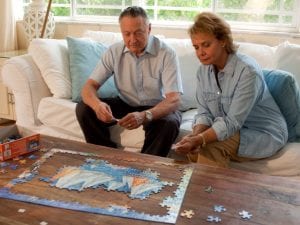 leisure activities that many people find enjoyable. Such activities can often be enjoyed even in the moderate and late stages of Alzheimer’s disease. Meaningful social activities can be either planned or spontaneous. Examples of planned social activities include birthday parties and family gatherings. Examples of spontaneous social activities include petting a dog or offering a hug to someone. Social activities help people feel connected with others in positive ways. People can experience their connections to others even when they are alone through something as simple as receiving a greeting card from someone.
leisure activities that many people find enjoyable. Such activities can often be enjoyed even in the moderate and late stages of Alzheimer’s disease. Meaningful social activities can be either planned or spontaneous. Examples of planned social activities include birthday parties and family gatherings. Examples of spontaneous social activities include petting a dog or offering a hug to someone. Social activities help people feel connected with others in positive ways. People can experience their connections to others even when they are alone through something as simple as receiving a greeting card from someone.
Doing vs. Being Activities
Most leisure activities involve active doing, especially physical activities like walking and exercising. It is very important that people with dementia perform physical activities each day to help maintain their physical fitness 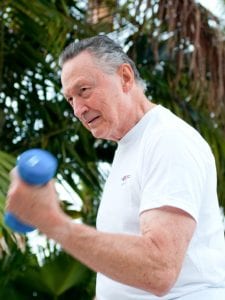 and capacities to the fullest extent possible. Having a reason to walk, like walking with a loved one or a pet, or being able to enjoy the outdoors, can help motivate physical activity. Some leisure activities are sedentary in nature, allowing us to have quiet and pleasurable experiences while sitting or standing still. These activities are sometimes called “being” activities. Being activities include anything from watching a beautiful sunset, flowers, fish swimming in an aquarium, birds outside a window or in an atrium, or children playing. People with dementia often maintain the capacities to enjoy being activities. The key is to balance the active and being activities so that the person is not fatigued or too sedentary.
and capacities to the fullest extent possible. Having a reason to walk, like walking with a loved one or a pet, or being able to enjoy the outdoors, can help motivate physical activity. Some leisure activities are sedentary in nature, allowing us to have quiet and pleasurable experiences while sitting or standing still. These activities are sometimes called “being” activities. Being activities include anything from watching a beautiful sunset, flowers, fish swimming in an aquarium, birds outside a window or in an atrium, or children playing. People with dementia often maintain the capacities to enjoy being activities. The key is to balance the active and being activities so that the person is not fatigued or too sedentary.
Spiritual Activities
Activities with a spiritual dimension can give special meaning and purpose to people’s lives. Examples include attending worship services or participating in prayer or meditation. Practicing spiritual activities such as meditation or prayer can help reduce stress and agitation or help cope with  difficult issues. People with Alzheimer’s disease can still be aware of their lifetime spiritual practices and religious orientations even in the advanced stages of the illness. It is therefore important that others understand and respect the spiritual preferences of each person. For example, even if individuals in the later stages of Alzheimer’s cannot read, they may still appreciate holding their holy books or religious symbols, or listening to spiritual music or chants. Those who can no longer communicate very well may still enjoy sitting through services or watching religious programs on television. Caregivers should be aware of a person’s spiritual preferences and try to include aspects of their spirituality in daily activities if appropriate.
difficult issues. People with Alzheimer’s disease can still be aware of their lifetime spiritual practices and religious orientations even in the advanced stages of the illness. It is therefore important that others understand and respect the spiritual preferences of each person. For example, even if individuals in the later stages of Alzheimer’s cannot read, they may still appreciate holding their holy books or religious symbols, or listening to spiritual music or chants. Those who can no longer communicate very well may still enjoy sitting through services or watching religious programs on television. Caregivers should be aware of a person’s spiritual preferences and try to include aspects of their spirituality in daily activities if appropriate.
Summary
In summary, the goal of activity-focused dementia care is to incorporate meaningful activities into the daily lives of those with dementia. Meaningful activities are voluntary, purposeful, socially and age-appropriate, interesting and engaging. Activities can be spontaneous or planned as part of regular routines or special events. They may be social, like cooking with other people, or solitary, like watching fish in an aquarium or birds at a bird feeder. What matters most about the use of activities in dementia care is that the activity is meaningful to that individual with Alzheimer’s.
Because any activity that is meaningful to a person can be used in activity-focused dementia care, this approach to care encompasses the entire day and all the potential activities that may fill it with meaning and purpose. The very best activity-focused care occurs when all those involved in caregiving participate to provide meaningful activities throughout the day. Some of the most important members of the care team include family members. But all members of the care team should understand what activities have meaning to each person and why, and to find ways to safely incorporate meaningful activities into the daily lives of those with dementia.
← Previous Lesson (Using Communication to Manage Challenging Behaviors)
→ Next Lesson (Activity-Focused Dementia Care: Person-Centered Care and Environments)
. . .
Written by: Wendy Wood, PhD, OTR, FAOTA (University of New Mexico)
Edited by: Mindy J. Kim-Miller, MD, PhD (University of Chicago School of Medicine)
References:
- Activity card sort: A measure of activity participation. (2001). St. Louis: Washington University School of Medicine.
- Association, A. (1995). Activity programming for persons with dementia: A sourcebook: Alzheimer’s Disease and Related Disorders Association, Inc.
- Association, A. (1997). Key elements of dementia care. Chicago: Alzheimer’s Disease and Related Disorders, Inc.
- Association, A. O. T. (2002). Occupational therapy practice framework: Domain and process. American Journal of Occupational Therapy, 56, 609-639.
- Bell, V., & Troxel, D. (1996). The best friend’s approach to Alzheimer’s care. Baltimore: Health Professions Press.
- Brod, M., Stewart, A. L., & Sands, L. (2000). Conceptualization of quality of life in dementia. In S. M. Albert & R. G. Logsdon (Eds.), Assessing quality of life in Alzheimer’s disease (pp. 3-16). New York: Springer Publishing Company, Inc.
- Carswell, A., Dulberg, C., Carson, L., & Zgola, J. (1995). The functional performance measure for persons with Alzheimer disease: Reliability and validity. Canadian Journal of Occupational Therapy, 62(2), 62-69.
- Cohen-Mansfield, J. (2001). Nonpharmacologic interventions for inappropriate behaviors in dementia: A review, summary, and critique. Am J Geriatric Psychiatry, 9(4), 361-381.
- Hasselkus, B. R. (1998). Occupation and well-being in dementia: The experience of day-care staff. American Journal of Occupational Therapy, 52(6), 423-434.
- Hasselkus, B. R. (2003). The meaning of everyday occupation. Thorofare, NJ: Slack, Inc.
- Hellen, C. R. (1998). Alzheimer’s disease: Activity focused care (2nd ed.). Boston: Butterworth Heinemann.
- Kitwood, T. (1997). Dementia reconsidered: The person comes first. Buckingham, UK: Open University Press.
- Lawton, M. P., Moss, M. S., Winter, L., & Hoffman, C. (2002). Motivation in later life: Personal projects and well-being. Psychology and aging, 17(4), 539-547.
- Lawton, M. P., Van Haitsma, K., & Klapper, J. A. (1996). Observed affect in nursing home residents. Journal of Gerontology: Psychological Sciences, 51B, P3-P14.
- Lawton, M. P., Van Haitsma, K., Perkinson, M., & Ruckdeschel, K. (2000). Observed affect and quality of life in dementia: Further affirmations and problems. In A. S. M. & R. G. Logsdon (Eds.), Assessing quality of life in Alzheimer’s disease (1st ed., pp. 95-110). New York: Springer Publishing Company, Inc.
- Lawton, M. P., Winter, L., Kleban, M. H., & Ruckdeschel, K. (1999). Affect and quality of life: Objective and subjective. Journal of aging and health, 11(2), 169-198.
- Perrin, T., & May, H. (2000). Wellbeing in dementia: An occupational approach for therapists and carers. Edinburgh: Churchill Livingstone.
- Rogers, J. C., Holm, M. B., Burgio, L. D., Granieri, E., Hsu, C., Hardin, J. M., et al. (1999). Improving morning care routines of nursing home residents with dementia. J Am Geriatr Soc, 47(9), 1049-1057.
- Rogers, J. C., Holm, M. B., Burgio, L. D., Hsu, C., Hardin, J. M., & McDowell, B. J. (2000). Excess disability during morning care in nursing home residents with dementia. Into Psychogeriatric, 12(2), 267-282.
- Sifton, C. B. (2000). Maximizing the functional abilities of persons with Alzheimer’s disease and related dementias. In M. P. Lawton & R. L. Rubinstein (Eds.), Interventions in dementia care: Toward improving quality of life. New York: Springer Publishing Company.
- Spector, W. D. (1997). Measuring functioning in daily activities for persons with dementia. Alzheimer Disease Assoc Discords, 11 Suppl 6, 81- 90.
- Weaverdyck, S. E. (1997). Assessment and care/service plans. In Key elements of dementia care (pp. 11-24): Alzheimer’s Disease and Related Disorder Association, Inc.
- Wells, D. L., & Dawson, P. (2000). Description of retained abilities in older persons with dementia. Res Nurs Health, 23(2), 158-166.
- Wells, D. L., Dawson, P., Sidani, S., Craig, D., & Pringle, D. (2000a). The benefits of abilities-focused morning care for residents with dementia and their caregivers. Perspectives, 24(1), 17.
- Wells, D. L., Dawson, P., Sidani, S., Craig, D., & Pringle, D. (2000b). Effects of an abilities-focused program of morning care on residents who have dementia and on caregivers. J Am Geriatr Soc, 48(4), 442-449.
- Wilcock, A. (1998a). Reflections on doing, being and becoming. Canadian Journal of Occupational Therapy, 65, 248-256.
- Wilcock, A. A. (1998b). An occupational perspective of health. Thorofare, NJ: Slack, Inc.
- Wood, W., Harris, S., Snider, M., & Patchel, S. (2005). Activity situations on an Alzheimer’s disease special care unit and resident environmental interactions, time use and affect. American Journal of Alzheimer’s Disease and Other Dementias, March/April, 105-118.
- Zgola, J. (1987). Doing things: A guide to programming activities for persons with Alzheimer’s disease and related disorders. Baltimore: John Hopkins University Press.
- Zgola, J. (1999). Care that works: A relationship approach to persons with dementia. Baltimore: Johns Hopkins University Press.

